Preliminary Remarks
Shortly after the Wehrmacht had occupied the Ukrainian city of Lemberg (30 June 1941), a work camp for jews was set up on Yanovska street. At the Nuremberg tribunal, the Soviet prosecution claimed that this facility had simultaneously served as a “death camp” where huge numbers of prisoners had been murdered. When the Red Army approached Lemberg in spring 1944, the SS allegedly ordered the mass graves to be opened and the bodies of the victims to be burned on huge pyres. The bones that survived the cremation were subsequently crushed and either buried or scattered on the territory of the camp. This is the official version of the events based on the investigations of the Extraordinary State Commission (ESC) and the testimony of surviving jewish inmates. The “bone mill” allegedly discovered after the arrival of the Red Army was repeatedly mentioned by the Soviet Prosecution in Nuremberg. Our research upon this question was prompted by three historical photographs of this mill which can be found on the Website of the United States Holocaust Memorial Museum (USHMM) and elsewhere.[1]
In the Ukrainian language, the camp at Janovska Street, Lemberg, is called “Yanivskij Tabor.” The Russian name is “Konzlager Yanovsky,” the English one, which will be used throughout this article, “Yanov Camp.”
The Extraordinary State Commission (ESC)
In November 1942, the Soviet Government founded the “Extraordinary State Commission,” an organization the size of a small Soviet ministry charged with investigating German war crimes. Wherever the Red Army had reconquered an area formerly under German control, local commissions were formed which subsequently questioned tens of thousands of local residents and produced reports based on their testimony. The same procedure was followed with regard to the former German concentration camps. The reports drafted by the local investigative commissions about the recently captured camps were directly forwarded to ESC headquarters in Moscow where they were usually edited and signed by one or several prominent ESC members before being published in the Soviet Press, such acquiring the status of official documents.
At Nuremberg, the Soviet prosecution submitted more than 500 such ESC reports to the court whereupon they were registered as “IMT Document USSR-###”. The Germans were indicted with four types of crimes: 1. Participation in a conspiracy for the accomplishment of a crime against peace; 2. Planning, initiating and waging a war of aggression; 3. War crimes; 4. Crimes against humanity. Each of the four victorious powers that staged the trial presented evidence for one of these indictments, the fourth type (“Crimes against humanity”) being assigned to the Soviet Union (crimes in the East) and France (crimes in the West).
This means that the German “crimes against humanity” in Eastern Europe were almost exclusively “proved” by the reports of the ESC, which were the sole evidence adduced by the Soviet prosecution and made available in English translation to the American, British and French judges. In other words, the commonly accepted history of German crimes in the East is largely based on the ESC reports submitted at the Nuremberg trial.
Even today numerous historians still regard the ESC reports as indisputable historical documents. However, an objective analysis clearly shows that this “evidence” is to a large extent based on manipulation and outright lies. The Soviet investigators regularly resorted to the strategy of having their atrocity propaganda “corroborated” by the witnesses they had recruited after the German retreat. As the commissions charged the Germans with truly gigantic massacres, they were facing a serious problem: Although there had undoubtedly been German mass shootings in the East, the Soviets were hardly ever able to present mass graves containing the alleged number of bodies. They therefore claimed that, facing certain defeat, the “German fascist intruders” had tried to obliterate the traces of their crimes by opening the mass graves, disinterring the corpses and burning them on pyres. The jews forced to perform this grisly task were subsequently liquidated as undesirable witnesses. The ashes of the victims were scattered on fields or in forests, dumped into rivers or used as fertilizer. The large bones which had survived the cremation were crushed in “bone mills.” This alleged obliteration of mass graves was a recurrent theme of Soviet war and postwar propaganda whose murky source are invariably the reports of the ESC. Our study deals with the “bone mill” presented as material evidence from the Yanov camp.
The charges pressed by the Soviet prosecution at Nuremberg
Although few people have ever heard of the labor camp at Yanovska Street, Lemberg, it played an important role at the Nuremberg trial. On 14 February 1946 Soviet Chief Prosecutor L. N. Smirnov read from a report describing body disposal at the Yanov camp: [2]
“The court has already received our exhibit USSR-6 (c). This document is an appendix to the report of the Extraordinary State Commission about the crimes perpetrated in the Lemberg area.[3] It is based on the testimony of the witness Manussewitsch who was questioned by the representative of the Public Prosecutor in the Lemberg area at the special behest of the Extraordinary State Commission. […] Manussewitsch was imprisoned by the Germans at the Yanov camp where he was assigned to a group of prisoners charged with burning the bodies of murdered Soviet citizens. Having cremated 40,000 bodies of people killed at the Yanov camp, the group was sent to a camp in the forest of Lissenitzky in order to perform similar tasks. I will now read the interrogation protocol. […] I quote:
‘In this camp special ten-day courses for the cremation of corpses were organized in the death factory. Twelve men were employed there. The students attending these courses came from the camps of Lublin, Warsaw etc. I do not know their family names, but they were no privates but officers, from colonel down to sergeant. These courses were taught by the chief of the crematoria, colonel Schallock.’
‘He explained where the bodies were to be disinterred and burned, how this task had to be put into practice, how the bone-grinding machine functions, how the pit is to be leveled, how trees are to be planted at this place and how the human ashes are to be scattered and hidden. Such courses were taught over a long period of time. […]’
Photographs of this machine, together with description – or a technical instruction, to be more precise – will later be made available to the court.” [End of Smirnov’s quotation.]
As the former camp inmate Manussewitsch did not claim to have attended any of these courses, it remains a mystery how he could possibly have known what skills had been taught there. His statement is apparently the only source mentioning such courses. Nor is it clear what he or his interrogators had in mind when referring to the “death factory” because nobody has ever disputed that the Yanov camp had been a labor camp producing equipment for the DAW (Deutsche Ausrüstungswerke). On 19 February 1946 Smirnov once again addressed the Yanov camp: [4 ]
“It results from the report of the Extraordinary State Commission about the crimes committed at the Yanov camp that in this camp, which formally passed for a simple labor camp, more than 200,000 Soviet citizens[5] were killed according to the investigations of the forensic experts. I confine myself to quoting the first paragraph of the Russian text on page 261:
‘In view of the fact that ashes and bones were scattered over a burial area comprising more than two square kilometers, the forensic commission estimates that over 200,000 Soviet citizens were exterminated in the Yanov camp.’”
On the afternoon of the same day Smirnov again referred to the “bone-grinding machine” mentioned by the witness Manussewitsch[6]:
“The machine for the grinding of burned bones was for this special purpose mounted on the platform of an automobile trailer. The machine can easily be transported by automobile or other means without being disassembled. The machine can be installed and operated anywhere without any preparations. […] The machine with the above-mentioned dimensions has an approximate capacity of 3 cubic meters of small burned bones.”
As Smirnov had contented himself with 40,000 bodies of murder victims allegedly disinterred and cremated at the Yanov camp during the German occupation whereas the ESC had put the number of exterminated Soviet citizens at 200,000, the mass graves must still have contained no fewer than 160,000 bodies. Even if “only” 100,000 people had been killed, 60,000 uncremated corpses must still have been buried on the territory of the former camp. Apparently no attempt was made to find them.
To put it in a nutshell: According to the Soviet version of the events, the large bones which had not been destroyed during the process of cremation were ground to “bone meal” in the above-mentioned “machine”. As the terminology used by the Soviets is rather imprecise, a short technical and historical retrospect will help us to clarify the matter.
Bones and Bone Mills
Both the Soviet documents and the Soviet Public Prosecutor at Nuremberg repeatedly used the clinical expression “machine for the grinding of human bones.” In propaganda more drastic terms were used: “Knochenmühle” (German), “bone crushing machine” or “bone mill” (English), “broyeuse d’os” (French), “kostedrobilka” (Russian) and “kistkodrobarka” (Ukrainian). What did a genuine bone mill look like, and how did it function? In this context one has to distinguish between the fresh bones of recently slaughtered cattle and human bones after cremation.
Fresh bones
It is a well-known fact that fresh bones are extremely robust. After 1840, the manufacture of bone meal from the bones of slaughtered cattle became economically important, as it had been discovered that it could be used as a fertilizer for plants (Justus von Liebig). The bones were first cooked or exposed to hot steam in order to extract the neatsfoot oil, the bone grease and the bone glue. In the process they became more brittle and could more easily be crushed after being dried in a kiln, even though massive machines were still needed for this work. Initially bone stampers driven by water power were used to perform the task. After mixing with stall manure, the bone granulate was used as fertilizer. As early as 1840, Liebig had developed a method of producing superphosphate (a compound of calcium hydrogen phosphate and calcium sulphate) from bone or mineral phosphates and sulphuric acid. This product is more soluble in water and therefore more suitable for plants than the calcium phosphate of the bones. Starting around 1855, the production of superphosphate became the most important branch of the fertilizer industry.
After 1870, the importance of bone crushing steadily decreased. The surviving bone mills now serve as tourist attractions. Instead of being crushed with such mills, the bones were thenceforth precrushed by means of steam-driven roll-type crushers, whereupon the neatsfoot oil and the bone glue were extracted. After being dried in a kiln, the product was ground, e. g. in an edge mill, the result being a mixture of grit and bone meal.[7] After sifting, the residual grit was also ground to bone meal, this time in a ball mill, as the chemical reaction with sulphuric acid to yield superphosphate requires a thorough grinding of the bones.
After 1900, bone meal was gradually replaced by imported mineral phosphates from abroad. Until 1914, Germany imported phosphate from her overseas colony of Nauru (Marshall Islands). In the meantime it had become known that bone meal can be used as a nutritious admixture to fodder and as such is too valuable to be used as fertilizer. Against the background of the economy of scarcity during the two World Wars, bone meal again gained some importance as a “home-grown source of phosphate”, and people gathered bones from kitchen scraps, as had been common practice in the nineteenth century.
Cremated bones
When speaking of “cremated bones,” Soviet Prosecutor Smirnov had referred to the nonburnable residues after the incineration of human bodies. During the cremation of a corpse, the small bones decompose into a coarse granulate while the larger ones, which are still sufficiently robust, do not. Although it is possible to crumble them with one’s fingers, they are harder and more solid than wood ashes. These bones – parts of skulls, thighbones etc. – are still easily recognizable after cremation.
In a crematorium oven, the cremated bones are gathered in an ash box separately from the residues of the fuel (at that time coke). Ideally the cremated bones are well carbonized, which means that the organic matter (grease, collagen) has been entirely burned and only whitish-light-grey calcium phosphate containing a small amount of calcium carbonate remains. In order to get them into the urn, the bigger bone fragments have to be crushed. In modern crematoria, this is done by means of an electric mill. The cremation of an adult person produces between 1.5 and 2 kg of cremated bones, depending on the size of the corpse.[8] It is therefore an error to presume that one can make a human body “completely disappear” by incineration.
Cremation on pyres
The tradition of cremating bodies on pyres, known since the Classical Era, required a large amount of firewood and was therefore the privilege of princes and kings exclusively. After the fire has gone out, the cremated bones are embedded in the wood ashes, but being easily recognizable, they can be gathered and and buried in an urn. In 1977 the retrieval of the urn of King Phillip of Macedonia (382-336 B.C.) caused a stir since it still contained Phillip´s cremated bones.
To the best of our knowledge, the only well documented case of a mass cremation on pyres in wartime happened after the Allied firebombing of Dresden (13/14 February 1945). To forestall the outbreak of epidemics, 6,865 corpses were burned within two or three weeks in Dresden´s Altmarkt. The cremation took place on grates formed by putting streetcar rails on bases made of brick on which the bodies were put in piles of 2-2.5 meters (Fig. 1).
The grates were so low that under them there was hardly any space for fuelwood which anyhow was scarce in the completely destroyed city. So the bodies were soaked with gasoline or Diesel fuel whereupon they smoldered for hours. This improvised cremation had very little in common with the incineration of a body in a crematorium.
Since only liquid fuel had been used, the cremation did not produce any wood ashes. On the other hand, the bones were (presumably) not burned completely and had still a relatively coarse structure. Nevertheless, as they were to be buried in a mass grave on Dresden’s Heidefriedhof, no further crushing was necessary. At any rate, the cremation fulfilled its purpose as no epidemics broke out. Cremating the 6,865 bodies required approximately fourteen days[9]. Thus only about 500 bodies could be incinerated per day although there were altogether eight pyres.
Now compare these statistics with the fantastic figures of corpses allegedly burned at the Yanov camp. Leon Weliczker, a former inmate of this camp, spoke of pyres on which between 500 and 2,000 bodies had been incinerated.[10] On the other hand, his description is utterly vague. Although he once mentions a pyre with over 2,000 corpses he remains silent as to its dimensions (floor space, height etc.) and he hardly volunteers any information about the time needed for the construction of the pyre and the duration of the cremation. Under these circumstances, no objective comparison with the pyres of Dresden is possible.
Bundesarchiv, Bild 183-08778-0001 / Hahn / CC-BY-SA [CC-BY-SA-3.0-de (http://creativecommons.org/licenses/by-sa/3.0/de/deed.en)], via Wikimedia Commons
Provided disinterred bodies were indeed burned on pyres, as is claimed for the Yanov camp and other places, the cremated bones would not have burned completely, and the cremation would have produced large amounts of wood ashes. The larger bones would still have been easily recognizable as human remains. According to the Soviet prosecution at Nuremberg, about 40,000 bodies were disinterred and subsequently incinerated on pyres at the Yanov camp. Since the purpose of this operation is supposed to have been the “traceless” disposal of the corpses, it would have been necessary to sieve and crush the bigger bones. Regardless of whether the Soviet claims were true or atrocity propaganda, the “bone mill” would have been an indispensable part of any mass cremation on pyres, and we realize the importance of such a machine for the credibility of the whole “pyre story”. But what evidence did Soviet prosecutor Smirnov adduce at Nuremberg? In order to prove the existence of such a device, he produced the testimonies of three former jewish prisoners, three photographs and the report of a local Soviet investigative commission.[11]
The photographs of the “bone mill” and their origin
Apparently the first photograph of the “bone mill” published in Germany was a poor reproduction in the magazine Sowjetunion heute (1981). Udo Walendy, who published this picture in his journal Historische Tatsachen, [12] rightly deplored its “poor quality” (Fig. 2).
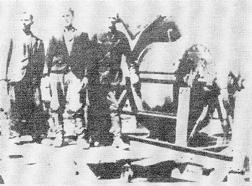
Photograph: APN (Soviet News Agency Nowosti), published in Sowjetunion heute and Historische Tatsachen.
In a book by Ernst Klee and Willy Dressen, this picture appears in somewhat better quality. [13] Walendy ventured some critical questions and remarks which predominantly referred to the alleged disposal of the bodies:[14]
- What kind of fuel was used? Wood? Coal? Oil? At that time all these fuels were in short supply.
- The alleged extent of the obliteration of traces by the SS at Yanow Camp is not credible. Why were no soil samples taken, no diggings performed and no foreign experts or journalists admitted?
- The alleged Himmler order from 1943 according to which hundreds of thousands of bodies were to be disinterred from the mass graves in the east and subsequently burned has never been found. Considering the development of the military situation in 1943 it would not have been possible to fulfill such an order anyhow.
With regard to the “bone mill”, Walendy doubts that a “massive” grinding of bones would have possible with such a “machine.” In an earlier article, he had stated:[15]
“Already at Nuremberg this case [the Yanov camp] was quietly dropped. Nobody has ever seen such ‘machines for grinding bones’. Neither were these claims taken seriously in the West, although the ‘40,000 corpses’ still haunt historical literature. No effort has been made to find the remains, and nobody talks about the ashes. After all, this might prompt some people to ask uncomfortable questions.”
As a matter of fact, western historians hardly ever mentioned the “machine” after the Nuremberg trial. But in Ukraine the machine became a museum attraction still shown to shuddering visitors and Ukrainian schoolchildren as evidence of the barbarism of the “German fascists.” However, the results of recent research, which we will now present, unmistakably proves that this version of events does not hold water. Since the collapse of the Soviet Union (1990), when an increasing number of Soviet archive documents became accessible in the West, three high-quality photographs of the “bone mill” have emerged. They can now be found on the Internet.
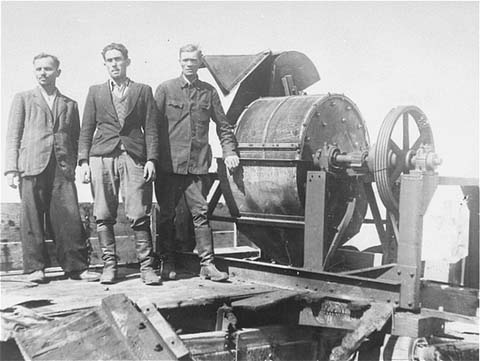
Sources: This work has been released into the public domain by its author, United States Holocaust Memorial Museum, courtesy of Belarusian State Archive of Documentary Film and Photography.
According to the USHMM,[16] this photograph dates from the period from 1 June to 1 October 1943. At that time, Lemberg was still under German control which means that the picture would have been taken by the SS. On the other hand, Sowjetunion heute clearly identifies the Soviet news agency Nowosti (APN) as the source of the very same photograph (Fig. 2). And yet another point: The USHMM formulation “in front of a bone mill” insinuates that there were several of such bone mills – in fact there was only this one example.
A second photo of the “bone crushing machine” is universally agreed to have been taken after the camp was closed.[17] According to the USHMM caption, the photograph was taken by a Soviet “war crimes commission” – in other words, by one of the local investigative subcommissions of the Moscow-based ESC. A translation of the Russian original reads as follows:
“For the illustration of the ESC report about the crimes of the Germans in the Lemberg area. In the camps of the Lemberg area the Germans exterminated hundreds of thousands of Soviet citizens, prisoners of war and citizens of other states. A German machine for grinding the bones of their cremated victims.”
The Mémorial de la Shoah even presents a photo print that is clearly of Soviet origin and has a Russian language caption quite different from the one quoted above:
“German machine, ‘kostedrobilka’ for grinding the bones of cremated bodies. This was done to camouflage the mass executions. The machine had been left on the territory of the Yanov camp and is being kept in Lemberg. (The picture was taken by criminal expert N. Gerasimov in August 1944 on behalf of the Extraordinary State Commission.”)[18]
While both are written in typical Soviet style, the captions of the photographs published by USHMM and the Mémorial de la Shoa respectively clearly differ. At any rate, there can be no doubt whatsoever as to the Soviet origin of this photograph. The third photograph shows Moses Korn, a member of the squad which had to operate the machine, standing beside the “bone mill” (Fig. 4).
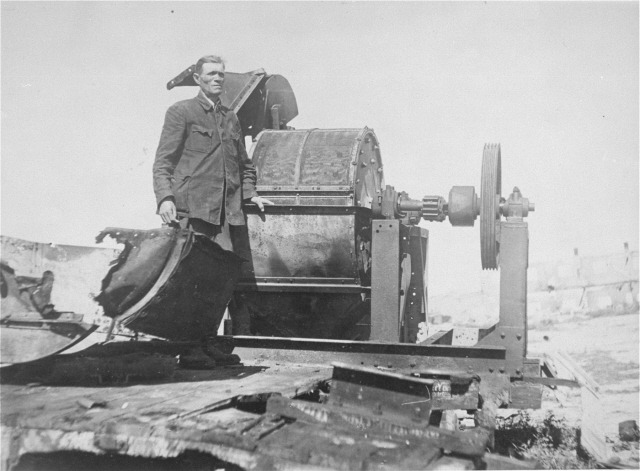
Photograph: ESC (1944), reproduced as USHMM (image # 67019A). Belarusian State Archive of Documentary Film and Photography. Public domain.
As to the origin of this photograph, USHMM volunteers the following information based on the protocol of a 1946 trial staged in Moscow against the SS leadership of the Yanov camp:
“Apparently, one of the accused was in possession of a photo of the Sonderkommando 1005 in Yanovska [Camp] and Moses was able to identify himself in the picture when it was shown to him at the trial.”
It is claimed that the picture was taken in the period from 1 June to 1 October 1943 (when Lemberg was still controlled by the Germans) although it is not clear where the USHMM got this information. Several facts speak against this claim:
- It is not credible that the SS should have taken pictures of a top secret operation such as the disposal of tens of thousands of bodies. Even if such pictures were indeed taken, an SS man would certainly have got rid of them before allowing himself to be arrested.
- When the picture was taken, the machine was severely damaged and out of use (see pictures 3 and 4). How can this be reconciled with the claim that it had been constantly used for crushing bones in the period from June to September 1943?
- In its caption, Sowjetunion heute, speaking of “three liberated prisoners”, identifies the ESC as its source, which means that the picture must of necessity have been taken after the Russian reconquest of Lemberg (27 July 1944). As Moses Korn is wearing the same clothes in both photographs, Fig. 4 was probably taken on the same day as that in Fig. 3 – in 1944 and not in 1943.
To resolve all doubts, the reproductions published by the Mémorial de la Shoah have Russian language explanations and attestation clauses. Translated into English, the attestation clause under Fig. 2 reads:
“I hereby confirm that this photograph is an exact copy of the original now in possession of the Extraordinary State Commission. Attested by the Extraordinary State Commission. 15. 1. 1946.” Translated into English, the Russian caption on the reverse side reads: “Korn, a former prisoner of the Yanov camp, who worked with the bone mill in the death brigade’.”
Better evidence that Fig. 2 was not discovered on an SS man is hardly needed. This should be a warning to all those who uncritically accept such claims.
Technical aspects of the “Bone Mill” – Part 1
Any technician confronted with these photographs will immediately ask himself what kind of machine they show. The first guess is that the “bone mill” was really a ball mill, a revolving drum containing steel balls. Through the hollow axle, grist is continuously fed into the drum and then crushed and ground by the steel balls tumbling inside. Thereupon it passes through a system of baffle plates and sieves fixed to the inner wall of the drum before trickling through the holes in the wall and falling into a receptacle.
This interpretation was confirmed by a brochure of the company Gröppel[19] dating from 1922 (Fig. 5). Although this brochure shows a bigger machine which is mounted on a concrete base, it is strikingly similar to the alleged bone mill. In other words, the three photographs show a ball mill, though it was not manufactured by the company Gröppel.
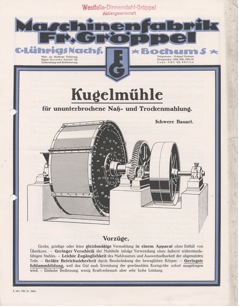
Fig. 5: Company brochure of the machine factory Franz Gröppel, Bochum 1922
According to the brochure, ball mills are particulary suited for hard, dry and brittle grist, such as various sorts of stones, ores, minerals, coal, salts, cinder etc. There is also a reference to the grinding of bones from the slaughterhouse (“degreased and degummed”).[20]
Could a ball mill be used to grind partially burned human bones? The bones that survive incineration in a crematorium oven are usually well-burned and can easily be crushed. During the initial phase of contemporary cremation, this was probably done by means of a mortar or a quern. Later an electromagnet was used to extract ferro-magnetic parts, such as coffin nails. This technique was further developed by giving the electromagnet the form of a pestle so that the crematorium worker could alternately extract the metal parts from the cremated bones and crush the bones after switching off the current. Nowadays the metal parts are first extracted (by hand or by means of the electromagnet) whereupon the bones are crushed in an electric mill. A ball mill, which is devised for continuous operation and for large amounts of grist, would be a poor choice for a crematorium. We will now examine the question if such a mill would have been suitable for the mass disposal of human bones allegedly practiced by the Germans in the occupied Soviet territories during World War Two.
Cremation was compulsory in the German concentration camps, and it was performed in accordance with the Feuerbestattungsgesetz (Law on Cremation) of 1934. The urn was usually sent to the cemetery of the deceased person’s hometown; if this was not feasible or considered undesirable for political reasons, it was buried in an anonymous mass grave in a nearby graveyard. Whether the concentration camps were equipped with electric mills is open to dispute. According to eyewitness statements, in some camps cremated bones were crushed by means of a pestle on a concrete base or a metal plate, which would have been a rather primitive technique. Incidentally such witness reports are contradicted by the fact that the Feuerbestattungsgesetz, which prescribed individual burial of the ashes in an urn, was observed in the concentration camps, at least until 1944.
The mass cremation of bodies on pyres allegedly practiced in the east obviously followed a different pattern. If we are to believe the official version of the events, 40,000 disinterred corpses were incinerated at the Yanov camp alone. This macabre task was allegedly assigned to “Sonderkommando 1005,” which used jewish slave workers to unearth the bodies and to build the pyres. “Sonderkommando 1005” is said to have been led by SD-Standartenführer[21] (Colonel) Paul Blobel. After the war, Blobel was among the defendants at the so-called Einsatzgruppen trial; 1948 he was sentenced to death and executed at Landsberg/Lech in 1951.
In view of the fact that the bones of a body incinerated on a pyre are not fully burned and remain relatively intact, a massive mill devised for crushing the large bones would undoubtedly have made sense. Using a ball mill at Yanov Camp would thus have been logical – provided that the story of the 40,000 disinterred corpses is true.
The expert report IMT Document USSR-61
The report of the Soviet investigative commission quoted by Smirnov at Nuremberg is undated, however it emerges from the text that the “machine” had been inspected on 29 September 1944. An English translation of this document had been made accessible to the American, British and French judges while the German defense lawyers had been provided with a German translation, which is now filed at the Munich-based Institut für Zeitgeschichte (Institute for Contemporary History). [22] The very first sentence reveals the propagandistic character of this report[23]:
“In compliance with the order of the district public prosecutor of 19 September 1944, on 29 September 1944 a commission presided over by the head of the regional railway executive committee of the city of Lwow, Krizhevitch, and consisting of the following members: Chief Engineer of the electro-mechanic factory no. 7 captain Tschekalin and Chief Mechanic of factory no. 7 first lieutenant Slessarev, inspected a machine used for grinding the bones of peaceful Soviet citizens who had been shot and burned by the German fascist robbers.”
The military ranks of the commission members suggest that they were members of the NKVD, which always closely cooperated with the ESC. As for the document, it is a mixture of technical descriptions and war propaganda. If we are to believe the authors of the report, they had discovered a special device, a fiendish invention of the “German fascists” who wanted to obliterate the traces of their horrendous crimes. Several references are made to the fact that the “machine” could be mounted on a truck trailer and was therefore mobile. Incidentally Soviet propaganda often spoke of transportable crematorium ovens (field crematoria) and mobile gas chambers (“gas vans”).[24] The mobility of these devices was regularly pointed out as evidence for the inexhaustible criminal energy of the “German fascists.”
The following sentence is of particular interest: “4. The machine had been manufactured at numerous different places as a special device for the grinding of cremated bones.” The fact that this “machine” was just a normal ball mill was passed over in silence; however the report twice stated that it had functioned “according to the principle of a ball mill.” No reference was made to the three photographs or to the fact that the drum of the mill carried the name of the manufacturer. The report does not explain when and under which circumstances the ball mill was found, nor does it point out that it was severely damaged. Another important question, the power source, will be dealt with later.
The Hunt for the “Bone Mill”
Does this ball mill still exist today? In February 2011 the Dresden newspaper Sächsische Zeitung published a report from Lemberg.[25] Its author had visited the Lemberg Museum of Contemporary History. One of the halls is dedicated to the German occupation (1941-1944). The German reporter wrote:
“‘Bone grinding machine’. This is the caption on the plaque in front of a 1.5 m metal device. These machines [plural!] were used when the [Yanov] camp administration began obliterating the traces of death in 1943. Prisoners were forced to disinter and burn the bodies and to grind the mortal remains.”
This article prompted the present author (K.S.) to travel to Lemberg. Accompanied by a female Ukrainian student who assisted me as an interpreter, I visited the Museum of Contemporary History, but to my dismay I could find no trace whatsoever of the expected ball mill. The only object we saw was the “1.5 m metal device” which the reporter had mistaken for a “bone mill”. Apparently the man had been so positive about his “discovery” that he did not even care to ask for a translation of the Ukrainian-language caption on the plaque. Had he done so, he would have learned that this device was part of a sowing machine (sijalka) allegedly used by the Germans to scatter the ground bones over the fields.
On our inquiry with the administration of the Museum, a friendly lady took an interest and phoned Kiev. We obtained the following information: After the war, the ball mill was indeed exhibited in Lemberg, but in the 1970s it had been sent to Kiev and was now an exhibit at the National Museum of the Great Patriotic War. It was casually mentioned that the device had been “reconstructed” at some point. In the meantime, my interpreter had discovered some photographs of this exhibit on the Internet (Fig. 6).
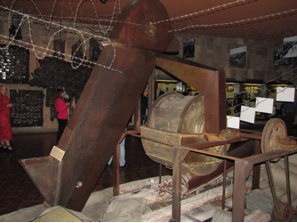
Source: Ukrainian Website, Kiev, 9 May 2010.
An enlarged version of the caption of the museum (Fig. 6, left, bright plaque) can be found on the same Website. Translated into English, it reads as follows:
“The bonemill. Germany. 1939.Was used by the Nazis to make fertilizer from the bones of prisoners who had been executed at the Yanov camp. During two months in 1942 alone, the Nazis exterminated up to 60,000 prisoners there, among them nearly 2,000 children. From 1941-1944, over 200,000 peaceful citizens and prisoners of war passed through this camp. In addition to Ukrainians, Russians and Poles, citizens of France, Czechoslovakia. , Yugoslavia, Italy, America and Britain were also interned there.”
This text, which apparently has remained unchanged since the Soviet period, invites some remarks:
- The formulation “Germany. 1939” could conjure up the idea that the mill had been manufactured in 1939 specifically for the impending war. This was not the case, for as we shall presently see, the mill is considerably older.
- The Yanow Camp was a work camp; to the best knowledge of the author there were no children in the camp.
- The formulation “over 200,000 peaceful citizens… passed through the camp” means that these people had been registered as prisoners of the camp, regardless of how long they had stayed there and how they had left it (through transfer to another camp, release or death). In the contemporary German documents, the number of registered prisoners was called “Durchgang” (throughput)\. While the Soviet prosecutor at Nuremberg had advanced the utterly incredible figure of 200,000 people murdered at the camp, the caption speaks of 200,000 prisoners who had passed through it. Even if this figure was accurate, it would furnish no clue as to the number of those who perished there. Incidentally, a “Durchgang” of 200,000 prisoners would have been impossibly high for the relatively small Yanov camp which was only operational for about two and a half years. For the sake of comparison: The Sachsenhausen concentration camp, which existed for eight and a half years and had been planned for 10,000 prisoners (although the actual number of inmates was much higher in the later period of its existence), had a “Durchgang” of about 140,000 (200,000 according to the exaggerated claims of the Soviets).
- The Yanov camp was a labor camp for the jewish population of Lemberg and its surroundings. Based on the testimony of jewish witnesses, Soviet propaganda claimed that “Yanovska” simultaneously served as a death camp where people were either shot right away or sent to Belzec to be gassed. In Soviet terminology, the alleged victims were usually called “peaceful citizens” (i. e. Soviet civilians). In addition to this category of prisoners, Soviet POWs and inmates from no fewer than nine countries were supposedly interned at the camp. Significantly one category of prisoners is passed over in silence –jews. During the Stalinist era, the jews as such were rarely mentioned. They were simply classified as citizens of their respective countries of origin, and no special emphasis was given to their suffering.
In a photograph published in Kiev a year later (2011), the “bone mill” is shown in new surroundings (Fig. 7). The sacks probably symbolize the ground bones and the wooden boards the former work platform. Barbed wire, whether stretched or in rolls, has nothing to do with a bone mill; this is simply a trick to conjure up an uncanny atmosphere and give visitors the creeps\.
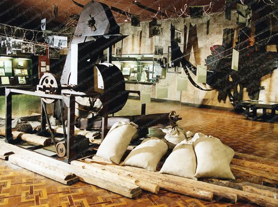
Source: Nikopolskaja Prawda[26]
Today’s photographs of the mill (Figures 6 and 7) have only a limited similarity with the historical ones (Figures 3 and 4) taken in 1944. Quite obviously the “machine” was patched up so that most visitors do not observe the massive damage visible in the photographs.
In order to learn more about the “post-war history” of the mill, the present author contacted the National Museum in Kiev, submitting several questions to the administration. To avoid misunderstandings I sent them all the photographs at my disposal. The friendly answer of the museum[27] can be summarized as follows:
All photographs submitted by the author show the same machine, which has been exhibited at the National Museum in Kiev since 1974. In 1981 it was “reconstructed”, however some parts got lost never to be found again. The drum carries the inscription “Grusonwerk Magdeburg – Buckau” but no concrete information about the manufacturer exists. The Museum conceded that the bone mill was “not specifically constructed for the NS concentration camps” and that the problem mentioned in the author’s message “is of interest and should certainly be investigated, using all available sources.”
So the “bone mill” still exists, and it was manufactured by Grusonwerk Magdeburg-Buckau (Fig. 8).
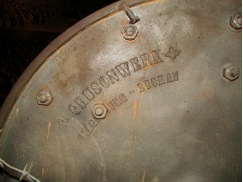
Photograph: Private (2011)
Grusonwerk Magdeburg-Buckau
Who would be more qualified to inform us about a machine than its manufacturer? Until 1945, Krupp-Guson was a well-known German company but after the Second World War it went through some turbulent times. Did the old archive of the firm still exist? Here a short digression into German industrial history is called for.
Hermann Gruson from Buckau near Magdeburg was an engineer, an inventor and a successful entrepreneur – an industrial pioneer of the 19th century. After his studies in Berlin and several positions as an industrial engineer, he started his own business in 1855, founding the “H. Gruson Machine Works and Shipyard Buckau-Magdeburg” which also comprised an iron foundry. By mixing several sorts of raw iron, Gruson developed a particularly hard cast iron which became the specialty of his firm and was to be used not only for the construction of machines and train wheels but also in the military field (tank turrets, cannons, shells). Basically Gruson manufactured all kinds of heavy machinery – including ball mills.
On the ball mill of Lemberg/Kiev, to the left and right of the word “Grusonwerk” a curious sign reminiscent of a four-pointed star is visible (Fig. 8). As a matter of fact, this is the trademark of Grusonwerk – a stylized horizontal drive shaft crossed by a standing artillery shell with an inscribed “HG” (Hermann Gruson). We see this trademark much better on an old business letter of Gruson´s company (Fig. 9).
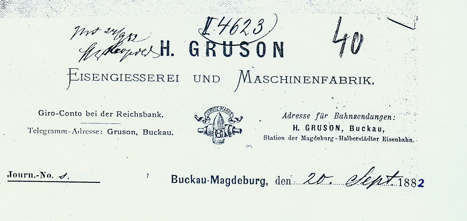
Fig. 9: Excerpt from a letter of the Gruson Factory dating from 1882, with trademark.
Gruson (Fig. 10), a benefactor and honored citizen of Magdeburg, was a socially progressive employer. In 1886 he incorporated his firm (Grusonwerk AG Magdeburg-Buckau). He retired in 1891. In 1893 the company was sold to Friedrich Krupp AG. Hermann Gruson passed away in 1895.
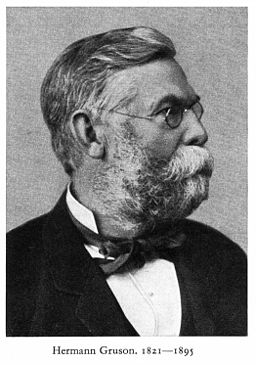
[Public domain], via Wikimedia Commons
After the company had been sold to Krupp (1893) it changed its name first to “Fried. Krupp Grusonwerk”, in 1903 to “Fried. Krupp A. G. Grusonwerk” and finally, in 1923, to “Fried. Krupp Grusonwerk AG Magdeburg”.
The company archive of Grusonwerk
The company “Fried. Krupp Grusonwerk AG Magdeburg” existed until 1945. During the Second World War, it produced mainly assault guns. On 16 January 1945, when Magdeburg became the target of a heavy bombing attack, 80% of the factory was destroyed. To what extent the firm archives survived remains unknown.
After the end of the war, Magdeburg was in the Soviet occupation zone, and the factory worked under Soviet-German directorship. Almost half of the still extant installations and machines were shipped to the Soviet Union as “reparations.”[28] Renamed “VEB Schwermaschinenbau-Kombinat Ernst Thälmann” (SKET) around 1950, the factory was one of the most important ones in East Germany. Many of the remaining documents from the “capitalist era” were destroyed. Today SKET no longer exists. The archives of the company now belong to the insolvency administrator but the surviving documents are not arranged in proper order and therefore practically useless. Under these cicrumstances, it would be unrealistic to hope that the old archives of Gruson-Werk could add to our knowledge about Gruson’s ball mills.
For this reason, the present author contacted three technical museums in German-speaking Europe: The Deutsches Museum in Munich, the Technisches Museum in Vienna and the Deutsches Historisches Museum in Berlin, all of which possess collections of old company documents. Some old documents of the Gruson company were indeed found but yielded relatively litte relevant information about our topic.
Technical aspects of the “Bone Mill” – Part 2
We will now try to elucidate some questions which come to mind with regard to the alleged bone mill (which we will henceforth call the “Yanov mill”). Owing to the lack of written documents, we will be compelled to resort to certain working hypotheses which we will consider as long as they remain unrefuted.
The background of the mill and the year of its construction
In view of the fact that the manufacturer of the Yanov mill was still called “Grusonwerk Magdeburg-Buckau” and that the mill displays Hermann Gruson’s trade mark, it stands to reason that it was manufactured before Gruson-Werk was sold to Krupp (1893). In other words, it was certainly not an invention of the “German Fascists” but must have been at least 50 years old in 1943. Today it is virtually impossible to ascertain how the mill came to Galicia from Magdeburg. Perhaps it was delivered to Galicia, which at that time belonged to Austria, shortly after being manufactured. Perhaps it was sent to the General Government after 1939, when Germany suffered of an acute shortage of material and was therefore forced to make use of old and scrapped machines.
The original supporting frame was removed and replaced by the present frame which is made of iron girders. This was probably done when the mill was placed on the trailer. While the fact that the mill was mounted on a trailer improved its mobility, it somewhat complicated its operation. As the trailer not only transported the machine but remained under it during operation, the new frame increased its stability under load. Undoubtedly since the filler hole was now too high for shoveling, a bucket conveyor was added which transported the grist from ground level up to the feed hopper.
Both the ball mill and the trailer were heavily damaged, presumably during the fighting which took place in Galicia in 1944. In the 1944 photographs the transmission belt of the mill is lacking, one side of the trailer is almost gone, one tire is flat, and Moses Korn is holding a jagged metal sheet in his hand (Fig. 6 and 7). The Soviet investigative commission did not mention this damage at all in its 1944 report. As the curators of the museum where the mill was later exhibited apparently understood that the pitiful state of the machine did not exactly illustrate the efficiency of the “German fascist body disposal technique”, the mill was “reconstructed” in 1981. What changes were made remains unknown to me.
The type of the machine
Several factors make it difficult to determine which of the various models of ball mills manufactured by Gruson the Yanov mill was. The mill is no longer in its original state, and the firm’s achives are in disarray. A brochure of Grusonwerk dating from 1890 only shows one of the heavy ball mills which were mounted on a base made of brick. On the other hand, I am in possession of a brochure of Fried. Krupp AG Grusonwerk which dates from 1915 and contains several pictures. As the models are not likely to have undergone signficant changes since 1890, we may assume that the Yanov mill belonged to Gruson’s lightest types (No. 0, 01, 1 or 2). All of them were mounted on a frame made of cast iron (Fig. 11). That is probably how the Yanov mill looked until at some unknown time the original frame was replaced by the present one, which is made of iron girders.
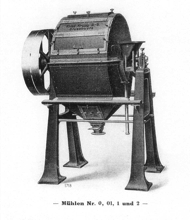
Source: Company brochure [29]
The size of the grinding drum is of some interest. According to the expert report presented by the Soviets in 1944 (IMT Document USSR-61) the inner diameter of the Yanov mill amounted to 900 mm and the breadth of the drum to 600 mm. A “private” measurement carried out in 2011 largely confirmed these data: The drum has a diameter of 900 mm (excluding the hub) or 1,000 mm (including the hub). The breadth of 600-700 mm is based on an estimate. A comparison with the data mentioned in the company brochure of 1915 shows no exact correspondence. The model most similar to the Yanov mill is no. 1, which had a breadth of 720 mm and an external diameter of the drum of 1050 mm.
The engine
According to the Krupp-Guson brochure, Type no. 1 had a demand (“power requirement”) of 2-3 HP. Unfortunately it does not furnish any information about the engine type, probably because this problem was supposed to be solved by the user. The Soviet expertise of 1944 laconically states: “ENGINE: The engine used is a Diesel engine of about 5 HP.”
If words have any meaning the authors of the expert report must have seen this Diesel engine. Unfortunately it has vanished without a trace, provided it ever existed. Around 1890, when the Yanov mill was manufactured, there were no Diesel engines. It is true that Rudolf Diesel applied for a patent for his trailblazing invention in 1893 but the first prototype became operational as late as 1897 and the first usable Diesel engines could only be used in stationary form or on ships on account of their considerable weight. Only after the invention of the fuel injection pump was the first Diesel-driven truck presented at the Berlin Automobile Exposition in 1924, and the first Limousine car with a Diesel engine ready for mass production was manufactured by Daimler Benz as late as 1936.
So what type of engine could have been used around 1890 for one of Gruson´s smaller ball mills? At the time large machines were still operated by steam but for small ones there already existed an alternative: The electric motor. As Fig. 12 shows, such an electric motor could indeed have been used to operate the Yanov mill. But since such a motor requires an electricity grid, the claim that the Yanov mill was mobile becomes highly dubious. While this factor would have been irrelevant if the mill had been permanently stationed at the camp, it could not have been used in a forest or a field where no electricity was available.
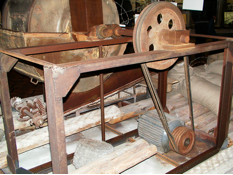
Photograph: Private, Kiev 2011.
One might object that the Yanov mill could have been retooled around 1940, the electric motor being replaced by a Diesel engine. But no small 5 HP (3.7 kW) Diesel engine such as that mentioned in the 1944 expert report existed at that time. Small Diesel engines were developed decades later, for example (in combination with a generator) as an emergency power source for single-family houses or – in the recent past – as engines for military drones. In all likelihood the Yanov mill had always been operated by an electric motor. Why the Soviet experts spoke of a “small Diesel engine” instead is anyone’s guess. Perhaps they felt that the time-honored electric motor would have been a poor choice for the fiendish, astonishingly mobile “Nazi technique”.
What was the mill really used for?
The countless incongruities of the official “bone mill” story strongly suggest that this machine belongs to the realm of atrocity propaganda like the “soap made from human fat” and the “gloves made from human skin” displayed at the very same museum. But if the mill was not used for the grinding of human bones, what was its real purpose?
An educated guess is that it was used in road construction. The city of Lemberg was situated on the so-called Durchgangsstrasse IV or Rollbahn Süd [30], an arterial road leading from Breslau past Cracow, Lemberg, Zloczow, Vinnitsya, Uman, Stalino (Donezk) to Rostov-on-Don and of crucial importance for the support of the German Heeresgruppe Süd. This road had to be improved, but rather than building a new road, already existing road sections and bridges were broadened and tarred. While the technical problems were taken care of by the Organisation Todt (OT), the camps for the forced laborers were run by the SS. Beginning in late 1941, over a dozen labor camps for Lemberg jews were set up in Galicia along the roadway.[31] The material used came from several nearby quarries. Pre-crushed stones were transported to the individual construction sites for further crushing with hammers (Fig. 13).
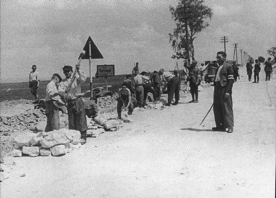
Photograph: Eliyahu Yones, Die Straße nach Lemberg
On the other hand, the finely granulated material for the lower and the upper base layers plus the protective layer was probably manufactured directly in the quarries, and ball mills would have facilitated this task. Nowadays the ideal grain size for an unbound base layer (i. e. a base layer not mixed with bitumen) is considered to be 0-22mm, 0-32 mm, 0-63 mm etc..[32] The grains used for the upper layer (protective layers) should have a size of 17-30 mm. The drill holes in the drum of the Yanov mill have a diameter of about 20 mm which means that the granules that passed through them must have been slightly smaller. This confirms that this mill could very well have been used in a quarry or a road construction site.
Do the photographs reveal where the mill was used?
According to the Soviet version of the events the “machine for the grinding of human bones” was found in the Yanov camp after the Red Army had reconquered Lemberg (27 July 1944). No documentary evidence corroborates this claim, and the three photographs do not prove it either. They are typical examples of Soviet “photographic evidence”: The vegetation, the position of the sun, shadows, buildings etc. – all these things are carefully blanked in order to prevent any identification of the time and the place where the picture was taken.
Fig.3 illustrates this technique perfectly: The surroundings of the mill are not visible at all. In the photo taken by the ESC during 1944, a brick wall can be discerned in the background on the left, and between the damaged trailer with the mill and the wall a small street with a sidewalk can be seen.[33] We are unable to explain the function of the black strap running from the machine over the road to the wall and the left edge of the picture.
Fig. 4 was obviously manipulated by changing the background of the right half. Upon closer inspection one can discern one or two houses and the rails of a narrow-gauge railway, which are more visible after contrast enhancement by means of an image editing program (Fig. 14).
Moses Korn is standing exactly upright and the rotary axis of the drum runs exactly horizontal (red line) – but the houses stand at an angle of 7.2° to the horizontal (green line)! Since a house is always built with horizontal floors and a horizontal roof ridge, even when standing on the steepest slope, the sloped houses in the picture can mean only one thing: that here, rather poorly, a false background was mounted into the picture!
This manipulation evidently served the purpose of hiding the real surroundings of the machine, which was probably a quarry or a road construction site far away from the Yanov camp. Under normal circumstances the machine could of course have been brought into the camp and photographed there, but because the trailer was severely damaged this was apparently not possible so that the Soviet commission was forced to resort to photomontage.
In this context one might wonder where the machine and the trailer had sustained the heavy damage visible on the photographs. In all likelihood it was not caused by deliberate demolition but by an artillery shell. As no fighting at or near the Yanov camp has ever been reported, this is further circumstantial evidence that the mill was found elsewhere.
Summary
At the Nuremberg tribunal of the “major war criminals” (1945/1946) the Soviet prosecution repeatedly mentioned a “machine for the grinding of human bones” allegedly used by the SS at the German labor camp Yanovska Street, Lemberg. The photographs of this “bone mill” were the only physical evidence presented for the mass murders allegedly perpetrated at this camp, the other “evidence” being the testimonies of former jewish prisoners and the confessions of captured SS men. According to the Soviet prosecution, 40,000 bodies had been exhumed, incinerated on huge pyres and the ashes had been distributed over the camp grounds. The big bones which had remained after the incineration were crushed and ground in the “bone mill.”
The machine still exists. It is now an exhibit at the National Museum of the History of the Great Patriotic War in Kiev where it is shown to horrified visitors as a proof of “German fascist barbarism”. Three historical photographs taken by the Soviet Extraordinary State Commission (ESC) in 1944 can be found at the United States Holocaust Memorial Museum in Washington, at the Mémorial de la Shoa in Paris and on their respective Websites.
The research carried out by this author has shown that the machine was nothing but a normal ball mill which had been manufacted around 1890 by Grusonwerk, Magdeburg. For several reasons (a modification of the frame, damage sustained during the war and finally a “reconstruction” at the museum) it is not possible to determine exactly which of the several Gruson models the mill was, but we can state with certainty that it was not a fiendish invention of the “German fascists.” The available evidence suggests that the Soviet story of the “bone mill” is a pure fabrication. Nothing proves that the mill was found at the Yanov camp after its liberation in July 1944. What purpose the machine served during the war cannot be determined with certainty. Our best guess is that it was used to produce finely ground road stone and that it was probably stationed in a quarry or a road bulding yard.
“Evidence” as dubious as the “bone mill” of Lemberg is insufficient to support the story of the 100,000 or even 200,000 jews murdered at Yanov Camp. Quite like the “gloves made of human skin” and the “soap made from human fat,” the “bone mill” is an invention of Soviet war propaganda. Up to now, the successor states of the Soviet Union have failed to jettison this mendacious legacy. Almost seven decades have elapsed since the end of World War Two. It is time for an objective analysis of this tragic period of European history.
 RSS Feed
RSS Feed















 October 8th, 2020
October 8th, 2020  Awake Goy
Awake Goy 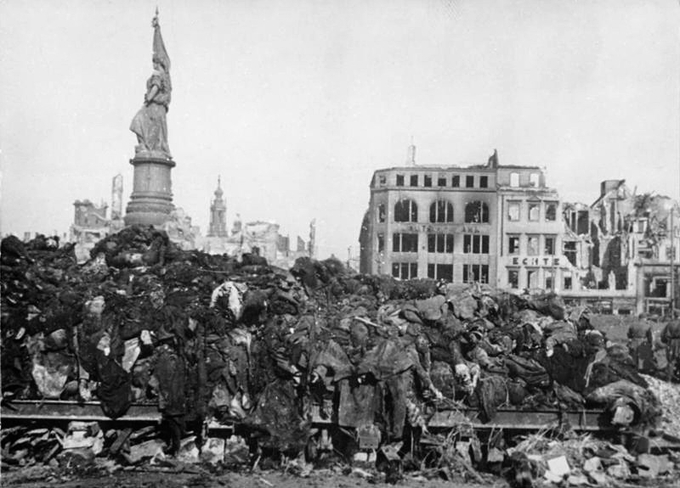
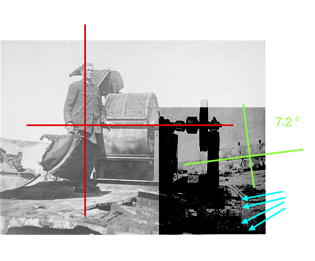
 Posted in
Posted in  Tags:
Tags: 













